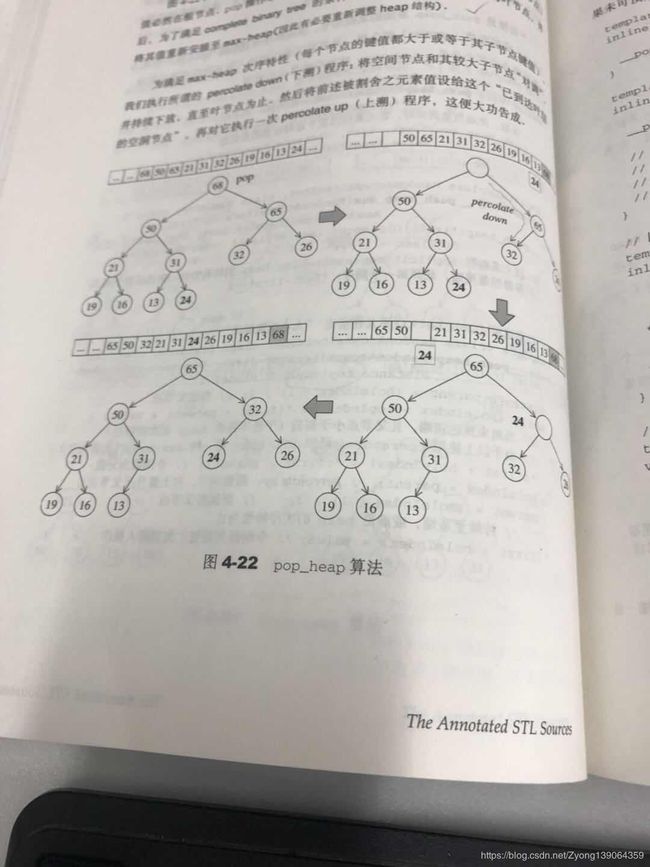heap的实现
binary heap是一种complete binary tree(完全二叉树)也就是说,整棵树binary tree除了最底层的叶节点之外,是填满的.而最底层的叶节点(s)
由左至右又不得有空隙 如图是一个complete binary tree.

使用了一个小技巧 就是将array数组的#0元素保留(或设为最大值或这无限小值),那么当complete bianry tree中的某个节点位于array的i处时,其左子节点
比位于array的2i处,其右子节点比位于array的2i+1处,父节点比位于i/2处.
根据元素的排列方式heap可分为max-heap和min-heap两种.前者每个节点的键值都大于或等于其子节点的键值.后者每个节点的键值都小于或等于其子节点的键值.因此
max-heap的最大值在根节点,并总是位于底层的array或者vector的起头出处
//push_heap的算法
/**
下面是push_heap算法的实现细节,该元素接受两个迭代器,用来表现一个heap底部容器(vector)的头尾,并且新元素已经插入到底部容器的最尾端.
*/
这是图示

template
inline void push_heap(RandomAccessIterator first,RandomAccessIterator last){
//注意,此函数被调用时,新元素已经置于底部容器的最尾端
__push_heap_aux(first,last,distance_type(first),value_type(first));
}
template
inline void __push_heap(RandomAccessIterator first,Distance holeIndex,Distance *,T *){
__push_heap(first,Distance((last-first)-1),Distance(0),T(*(last-1)));
//以上系根据implicit representation heap的结构特性,新值必须位于底部
//容器的最尾端,此即第一个洞号:(last-first)-1
}
//一下这组push_back()不允许指定"大小比较标准"
template
void __push_heap(RandomAccessIterator first,Distance holeIndex,Distance topIndex,T value){
Distance parent=(holeIndex-1)/2;//找出父节点
while (holeIndex>topIndex&&*(first+parent) 既然是max-heap,最大值必然在根节点.pop操作取走根节点.为满足complete binary tree的条件,必须割舍最下层
最右边的叶子节点,并将其值重新安插至max-heap.
//下面是pop-heap算法的实现细节.该函数接受两个迭代器,用来表示一个heap底部容器(vector)的头尾.

template
inline void pop_heap(RandomAccessIterator first,RandomAccessIterator last)
{
__pop_heap_aux(first,last,value_type(first));
}
template
inline void __pop_heap_aux(RandomAccessIterator first,RandomAccessIterator last,T*)
{
__pop_heap(first,last-1,last-1,T(*(last-template
inline void pop_heap(RandomAccessIterator first,RandomAccessIterator last)
{
__pop_heap_aux(first,last,value_type(first));
}
template
inline void __pop_heap_aux(RandomAc1)),distance_type(first));
//根据heap的次序特性,pop操作的结果应为底部容器的第一个元素,因此,首先设定欲调整值为尾值,然后将
//首值调整至尾节点,(所以以上将迭代器result设为last-1)
}
//以下这组__pop_heap()不允许指定"大小比较标准"
template
inline void __pop_heap(RandomAccessIterator first,RandomAccessIterator last,RandomAccessIterator result,T value,Distance*)
{
*result=*first;//设定尾值为首值,于是尾值就是欲求结果,可由客户端稍后再以底层容器之pop_back()取出尾值
__adjust_heap(first,Distance(0),Distance(last-first),value);
//以上欲重新调整heap,洞号为0(也就是树根出),欲调整值为value(原尾值)
}
//一下这个__adjust_heap()不允许指定"大小比较标准"
template
void __adjust_heap(RandomAccessIterator first,Distance holeIndex,Distance len,T value)
{
Distance topIndex=holeIndex;
Distance secondChild=2*holeIndex+2;//洞节点之右子节点
while(secondChild 
注意pop_heap之后,最大元素只是被放置于底部容器最尾端,尚未被取走.如果要取走其值,可用容器底部(vector)所提供的back()操作函数.如果要
//移除它,可使用底部容器(vector)所提供的pop_back()函数
既然每次pop_heap可获得heap键中最大的元素,如果持续对整个heap做pop_heap操作,每次操作范围从后向前缩减一个元素
因为pop_heap会把键值最大的元素放在底部容器的最尾端 当整个程序执行完毕的时候,我们便有了一个递增序列
注意 排序过后,原来的heap就不再是一个合法的heap了
//以下这个sort_heap()不允许指定"大小比较标准"
template
void sort_heap(RandomAccessIterator first,RandomAccessIterator last){
//以下,每执行一次pop_heap().极值就被放到了最尾端
//扣除尾端在执行一次pop_heap(),次极值又被放在了尾端
//一直下去,最后得到排序结果
while(last-first>1)
pop_heap(first,last--);//每执行pop_heap一次,操作范围即退缩一格
}
//这个算法用来将一段现有的数据转化为一个heap
//将[first,last)排列成为一个heap
template
inline void make_heap(RandomAccessIterator first,RandomAccessIterator last)
{
__make_heap(first,last,value_type(first),distance_type(first));
}
//一下这组make_heap()不允许指定"大小比较标准"
template
void __make_heap(RandomAccessIterator first,RandomAccessIterator last,T*,Distance *)
{
if(last-first<2) return;//如果长度为0或者是1,那么不必重新排列
Distance len=last-first;
//找出第一个不需要重排的子树头部,以parent标出
Distance parent=(len-2)/2;
while(true){
//重排以parent为首的子树,len是为了让 __adjust_heap()判断操作范围
__adjust_heap(first,parent,len,T(*(first+parent)));
if (parent==0) return ;//走完根节点,结束
parent--;
}
}
下面给出一个测试实例
#include
#include
#include
using namespace std;
int main(){
{
//test heap(底层以vecotr 完成)
int ia[9]={0,1,2,3,4,8,9,3,5};
vectorivec(ia,ia+9);
make_heap(ivec.begin(),ivec.end());
for(int i=0;i